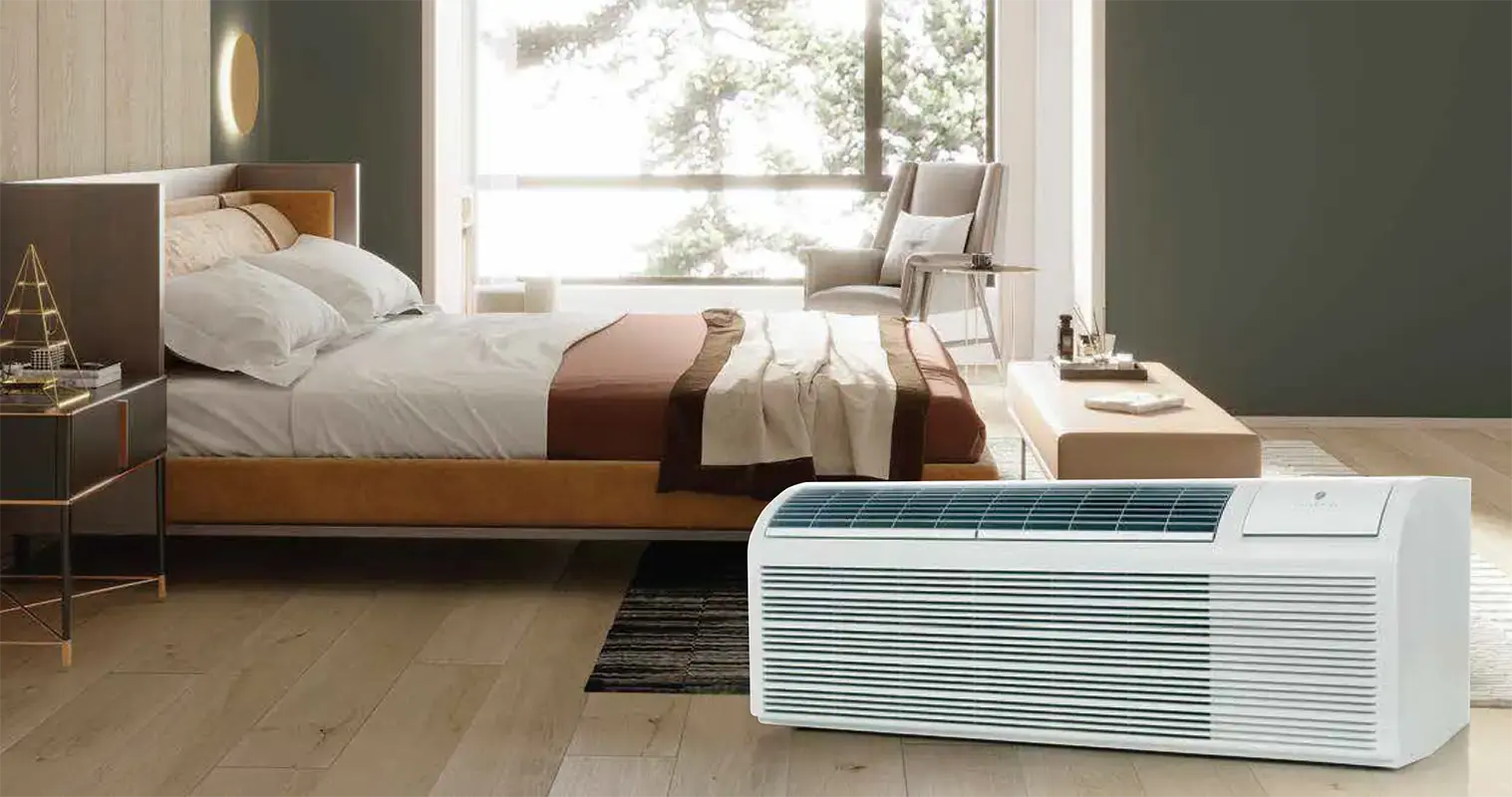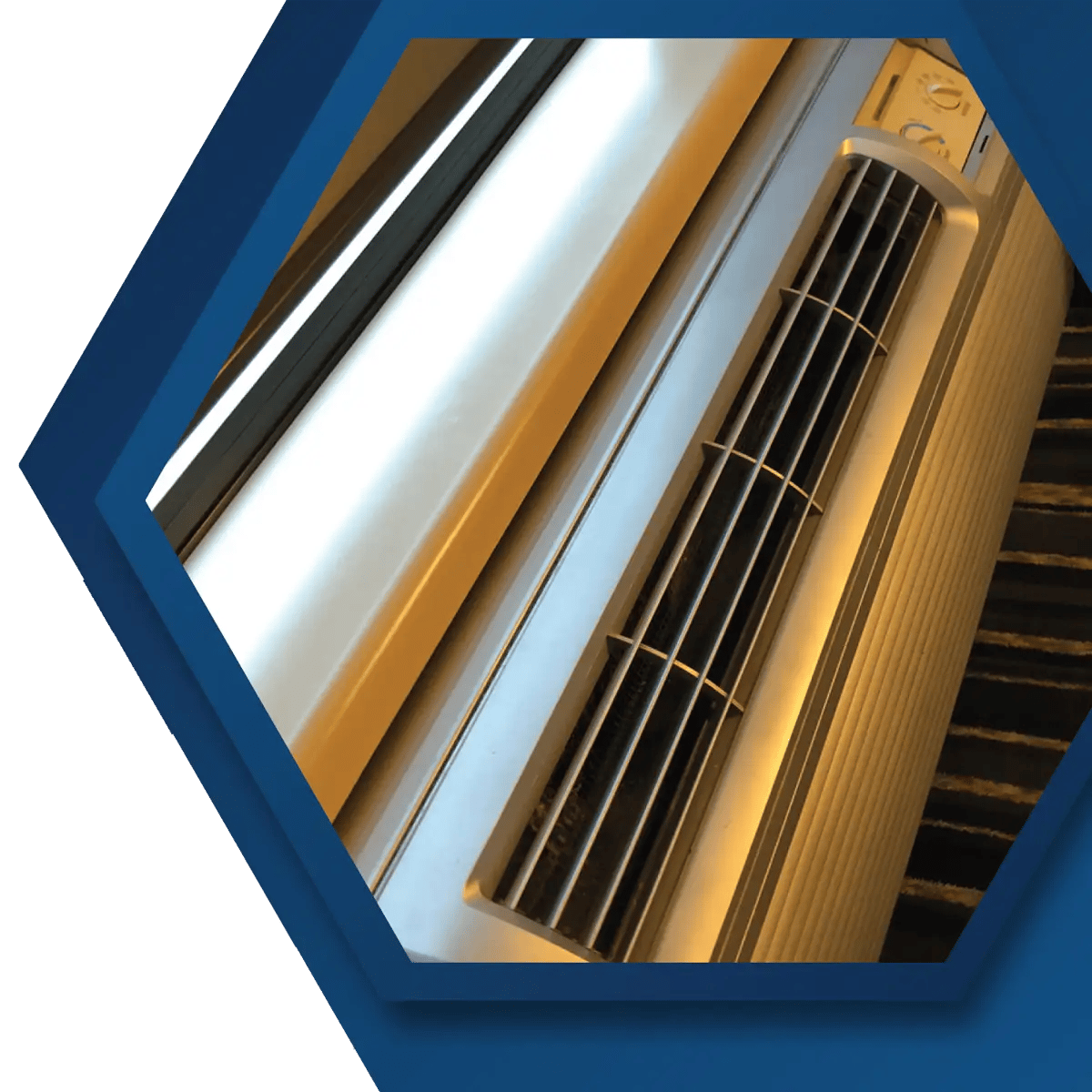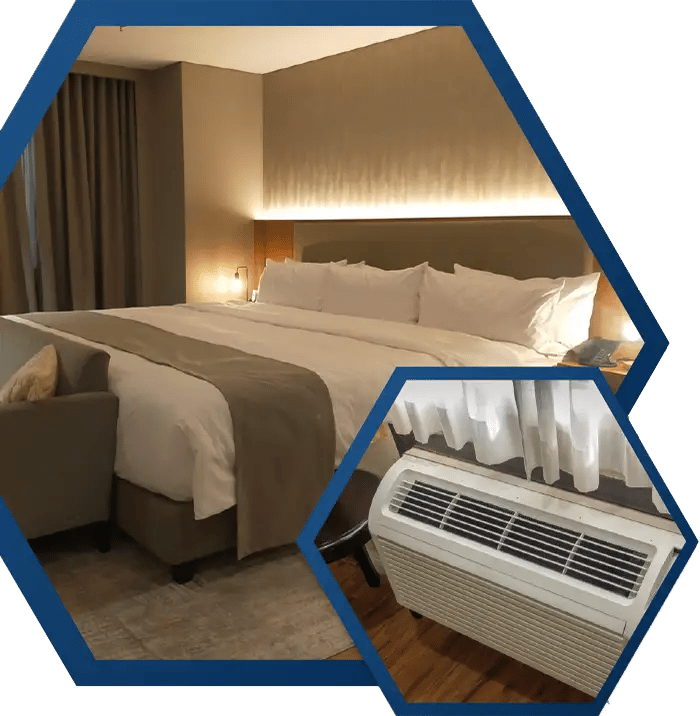What Is a PTAC (and Where Should You Be Using One)?

If you work commercial/light commercial and you’re still treating packaged terminal air conditioners (PTACs) like “those old loud hotel units,” it’s time for an update.
A PTAC is a self-contained heating and cooling unit that slides into a wall sleeve and serves a single room or zone. There is no ductwork, no mechanical room, no tying into a central air handler. The unit is set into the wall, wired, and sealed. That space now has its own thermostat and its own capacity.
This “self-contained room comfort” is the whole appeal. If one unit dies, you’re not ripping comfort away from an entire wing. You’re swapping a box. That one room is back in service in minutes. For hotels, student housing, senior living, dorms, modular classrooms, etc., that’s a big deal. Downtime hits revenue, fast.
Why People Spec PTACs Instead of Going Central

Fast Install and Fast Swap
PTACs are modular. Techs can access coils, filters, blower, boards, etc. from the front. If a unit goes down in a dorm room or a hotel room, you don’t need to send an engineer to chase an air handler in a locked closet somewhere. You just swap it, repair the bad one on your own time, and keep the room rentable.

Each Room Is Its Own Zone
No arguing over setpoint. The guest in 214 can run 67°F and the guest in 215 can run 73°F, and they’re both happy. Same story in student or shared housing; one loud complaint doesn’t become a building-wide “the AC is broken” situation.

Better Sound and Efficiency Than the Old-School Stuff
The newer inverter-driven PTAC lines (like Friedrich’s FreshAire and ZoneAire Premier) ramp instead of slam on/off. That does a few things you’ll like:
- Quieter starts (no “kick” noise)
- Tighter temperature control; less swing between “freezing” and “stale”
- Lower energy use at part load instead of just blasting full tilt 24/7
On paper you’ll see numbers like EER up to the low teens, but the real story is how they throttle to match load instead of short cycle. That’s comfort plus utility savings.
Fresh air and IAQ is now part of the sell
One big shift in the last few years: indoor air quality is not optional in certain markets anymore.
Some PTAC models now bring in conditioned, filtered outside air. It’s not just “crack a vent,” they’re providing actual make-up air that’s run across the coil, filtered (MERV 8), and delivered into the room at controlled humidity. That helps hit ASHRAE 62.1 ventilation targets and keeps mold risk down in tight building envelopes.

Why you care:
- Hotels want to be able to say “fresh air” and mean it.
- Universities and dorms are getting hammered on humidity and odor complaints.
- Owners want fewer IAQ headaches and fewer late-night calls about “my room smells.”
If you can walk in and say, “This unit conditions its own outside air and helps reduce the load on your DOAS,” you’re not just the guy quoting tonnage; you’re the guy solving air quality and code.
Where PTACs Make the Most Sense

Here’s where we see these units achieve repeated wins:
- Hotels/Hospitality: Still the #1 use case. Quiet matters, humidity control matters, and if one room goes down you do NOT want that to knock a whole floor out of service. PTAC is the best solution for the space.
- Multifamily/Student Housing/Dorms: Schools and property managers like that you can do room-by-room conditioning and fresh air without adding a giant ducted system. Also: you can downsize the central ventilation system because every unit helps pull in/condition air directly to the room. That keeps first cost down and keeps retrofits realistic in older buildings.
- Modular Classrooms/Temporary/Offsite Offices: Fast to install, doesn’t eat floor space, and gives each classroom its own thermostat.
- Light Commercial/Telecom/Equipment Shelters: Small footprint, steady cooling, simple service access.
- Senior Living/Assisted Living Suites: This is the same story as the hotel setting: individual comfort, fast swaps if something fails.
If you’re doing service work or quoting replacements, think in terms of: “Does this building really need a full central system, or do they actually just need reliable room units they can stock a spare of?” In a lot of older hotels and dorms, ripping and replacing PTAC-for-PTAC is the only move that fits budget and timeline.
PTACs: The Perfect Pitch
Leading with BTUs won’t get the job won. If you’re pitching this kind of equipment, start with money saved and uptime gained:
- “When one unit fails, you’re not taking 20 rooms down. You’re taking one room down for 10 minutes.”
- “Modern units achieve quieter operation and tighter humidity control than the old clunky PTACs.”
- “We can bring in filtered, conditioned outside air to help you hit ventilation expectations without rebuilding your whole duct system.”
- “You can keep a spare on site. You don’t need to call for equipment at 2am.”
Keeping it simple. That’s how PTACs get it won.
PTACs: Bottom Line
Modern PTACs are not just “cheap hotel ACs.” The better ones are inverter-driven, quieter, humidity-aware, and can actually bring in and treat outside air. They’re built for hotels, dorms, senior living, modular classrooms, telecom closets. They’re best anywhere you need each room to be its own little climate island and you cannot afford downtime on the whole building.
If that sounds like 80% of the calls you get, this gear should already be on your line card. Learn more about the PTAC’s 2J carries here.
